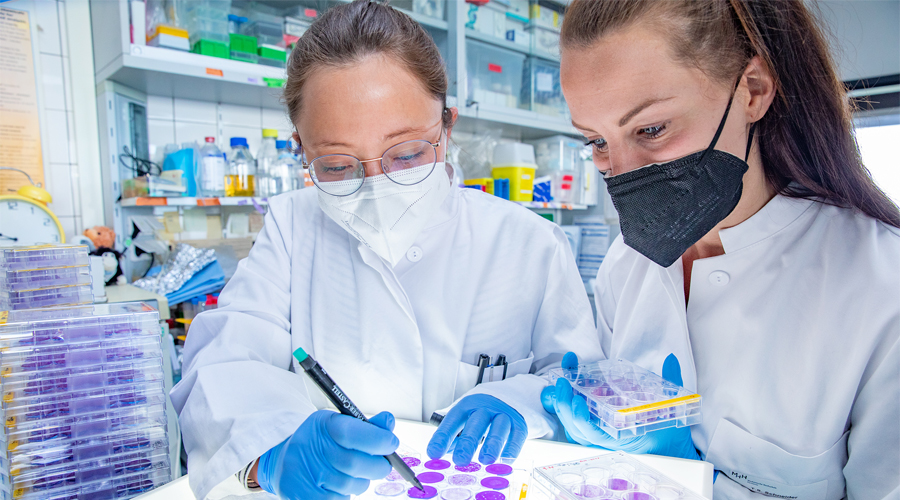Team investigates approaches for new drugs that act against many different coronaviruses:
Finding active agents against SARS-CoV-2 and, if possible, against other coronaviruses – this is the goal that a team led by RESIST-Speaker Prof. Schulz, Institute of Virology at the Hannover Medical School (MHH) and coordinator of two research areas at the German Centre for Infection Research (DZIF), has been pursuing since the virus first appeared. Together with a team led by Professor Dr John Ziebuhr, Institute of Medical Virology at Justus Liebig University Giessen, it is now funded by the DZIF with around 440,000 euros.
So far, the scientists have already succeeded in picking out 300 substances from a collection of around 60,000 low-molecular compounds that can inhibit the human coronavirus HCoV-229E, which is related to SARS-CoV-2 but more harmless. They carried out this work, among others, with the team of Prof. Pietschmann from TWINCORE – Centre for Experimental and Clinical Infection Research. The research team has so far been able to show that eight of these substances can also inhibit SARS-CoV-2 particularly effectively.
The special path to the goal
Now the researchers will explore where exactly and, above all, how the best five of these promising molecules work. “For example, we are investigating what exactly their target structure is – i.e. whether they act in the virus or in the cell – and what they change there. For example, do they inhibit a viral enzyme or do they change structures that are essential for the reproduction of coronaviruses?” explains Dr Amelie Wachs from Prof. Schulz’s research group. “By identifying possibly new target structures, we hope to learn previously unknown details about the virus. Building on this knowledge – possibly after further optimisation of this substance – new effective drugs could be created,” adds her colleague Talia Schneider.
The path of this research group is a special one, because many other teams are looking for substances that can bind to an already known target structure of the SARS-CoV-2 virus and thus inhibit it. If they do so using compounds that are already approved as drugs, or compounds for which there is already extensive safety data regarding their use in humans, the results will be able to be applied in the clinic relatively quickly. However, they are less productive in terms of new insights into SARS-CoV-2 and other coronaviruses. In contrast, the approach of the project now funded by the DZIF to screen previously uncharacterised substances and subsequently identify their targets offers new possibilities: Previously unknown starting points for drugs can be found that are effective against as many different coronaviruses as possible.
The team’s research is particularly important for older and immunocompromised people, as they have an increased risk of a severe course of SARS-CoV-2 infection. These people are also the focus of RESIST.
The photo shows Dr. Amelie Wachs (left) and Talia Schneider in a laboratory of the Institute of Virology. They are evaluating so-called plaque assays, for which cell culture plates were infected with coronaviruses. Copyright: MHH/Kaiser.

